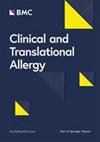Eosinophils and COVID-19: Insights into immune complexity and vaccine safety
Abstract
Background
COVID-19 exhibits a variety of symptoms and may lead to multi-organ failure and death. This clinical complexity is exacerbated by significant immune dysregulation affecting nearly all cells of the innate and adaptive immune system. Granulocytes, including eosinophils, are affected by SARS-CoV-2.
Objectives
Eosinophil responses remain poorly understood despite early recognition of eosinopenia as a hallmark feature of COVID-19 severity.
Results
The heterogeneous nature of eosinophil responses categorizes them as dual-function cells with contradictory effects. Eosinophil activation can suppress virus-induced inflammation by releasing type 2 cytokines like IL-13 and granular proteins with antiviral action such as eosinophil-derived neurotoxins and eosinophil cationic protein, and also by acting as antigen-presenting cells. In contrast, eosinophil accumulation in the lungs can induce tissue damage triggered by cytokines or hormones like IFN-γ and leptin. Additionally, they can affect adaptive immune functions by interacting with T cells through direct formation of membrane complexes or soluble mediator action. Individuals with allergic disorders who have elevated levels of eosinophils in tissues and blood, such as asthma, do not appear to be at an increased risk of developing severe COVID-19 following SARS-CoV-2 infection. However, the SARS-CoV-2 vaccine appears to be associated with complications and eosinophilic infiltrate-induced immunopathogenicity, which can be mitigated by corticosteroid, anti-histamines and anti-IL-5 therapy and avoided by modifying adjuvants or excipients.
Conclusion
This review highlights the importance of eosinophils in COVID-19 and contributes to a better understanding of their role during natural infection and vaccination.


 求助内容:
求助内容: 应助结果提醒方式:
应助结果提醒方式:


